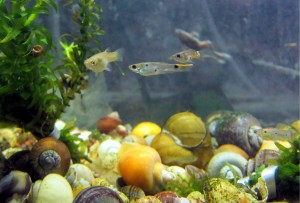Female guppies have a built-in mechanism to avoid inbreeding, according to a new study in Proceedings of the Royal Society B. Scientists at Italy’s University of Padua reported that when female guppies are inseminated with an equal quantity of sperm from both a related and unrelated male, the unrelated male sires 10 percent more of the resultant fry than does the related male. Other female guppies that mated with either an unrelated male or a related male produced broods of roughly equal size, suggesting that embryo survival was not affected by mating with a close relative. The researchers, Clelia Gasparini and Andrea Pilastro, found that when sperm from a male guppy is placed in the ovarian fluid of a sister, it travels at a slower speed than does guppy sperm in the ovarian fluid of an unrelated female. The researchers conducted the study to uncover evidence that polyandry–the practice of a female mating with multiple males–came about to prevent inbreeding. Other factors being equal, females that mated with multiple males, the theory holds, are more likely to mate with a non-relative than are females that mate with only one male. Inbreeding, or mating with close relatives, can lower the survival of a population by increasing the tendency toward genetic diseases. Before Gasparini and Pilastro conducted their study, scientists assumed that there were natural control mechanisms to avoid mating between relatives, but they did not have any evidence to support this view. True, female guppies seem to prefer mates with colors and other physical characteristics different than those of local males. However, when appearance is not a factor, female guppies aren’t very good at distinguishing unrelated males from related males. Also, female guppies are often unsuccessful avoiding mating attempts from males they aren’t interested in. For these reasons, the two Italian scientists deduced that there must be some mechanism in place to hinder inbreeding aftermating has taken place. It is not yet known which factor or factors in ovarian fluid hinders the movement of a sibling’s sperm. Finding the cause, the two authors write, is a topic for a future study.
-
Recent Posts
Recent Comments
- Spine on National Local Fish Store Meet Up Day: July 13, 2013
- Eugen on I’m Back!
- Terri on Shop Report: Rick’s Fish and Pet Supply
- Sonny Disposition on Shop Report: Rick’s Fish and Pet Supply
- Marge Collins on Shop Report: Rick’s Fish and Pet Supply
Archives
Categories
Meta

